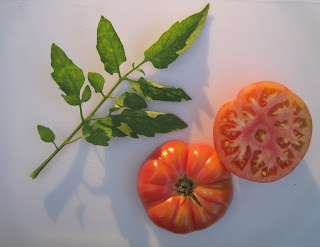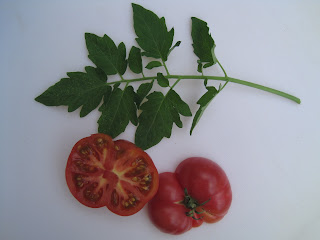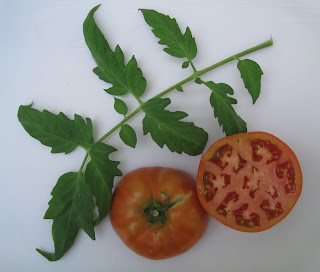Friday, August 31, 2012
Black From Tula
Tuesday, August 28, 2012
Demimonde
Angeles City Native
When I grew this variety in 2011, the fruit were excessively acidic and very prone to blossom end rot. This year, only the first two fruit showed blossom end rot and the fruit were much more balanced. It is essentially a grocery store tomato, although unlike American commercial varieties which tend to be hybrids, this one appears to be open pollenated and stable. Flavor is similar to a generic roma but with more of an acid bite. Fruit are very firm and meaty with relatively little gel and few seeds. Admittedly, not the most delicious tomato you will ever taste but it is a strong, productive and unique plant.
Mexico Midget
From Mexico. Possibly solanum pimpinellifolium, or a currant tomato, a separate species of solanum that readily crossbreeds with other tomatoes. Foliage is wispy and vines are long. This variety is slow to germinate. For the last two years I had all but given up when the seedlings finally emerged. Once the plant matures, it puts out a profusion of small fruit with a full "big tomato" taste. This variety also readily reseeds itself, dropping its small fruit to provide a small army of volunteers the next year.
Calf's Heart
From Serbia. Large robust plants with wispy foliage produce
a very heavy crop of large pink oxhearts. Many heavy producers lack taste but Calf's
Heart is an exception. It is meaty but not overly dry so it is well suited for
a number of uses. This variety has a nice, rich tomato taste with just a hint of pumpkin, a subtle
flavor that I have noticed in other oxhearts. A good choice for a
single-variety garden.
Saturday, August 25, 2012
Talavera Native
Early Kus Ali
Tuesday, August 21, 2012
German Queen
This is that other large pink-fruited beefsteak on a potato leafed plant. Comparisons between German Queen and Brandywine are inevitable but after growing both for a few years, my preference is with German Queen. I always detect a certain earthy undertone in Brandywine that makes it unique but less than perfect. German Queen is just a touch milder than Brandywine and is almost perfectly balanced between sweetness and acid with a hint of pumpkin. German Queen is also a very meaty beefsteak with few seeds and little gel which makes it a great slicer. It would also make a nice salsa or marinara but given the modest to moderate productivity of the big plants, I would be reluctant to use such an excellent fruit for cooking. Presumably, originally from Germany.
Sunday, August 19, 2012
Squarehead Pink
Below is the neatly trimmed parent tomato as found in a Seoul market....
Basrah Rocket
I had a very small garden there. Basically just two containers I built into the cinderblock wall I used to reinforce my living area from rocket attacks. Here are a few watermelon plants that seemed to really love the heat. They germinated within 48 hours in the scaldingly hot soil.
I also had some luck with cilantro during the late winter months when it was still cool but tomatoes were generally a no-go. The temperature differences between day and night were too great and then before long it was too hot during the day and they dropped their blossoms.
A coworker also had a small garden near his quarters. His was considerably more aesthetically pleasing. I think he was growing sunflowers, cilantro and perhaps squash.
A few days after discovering that I was not the only one with a garden, I noticed that some local Iraqis who did cleaning and maintenance contracting work were also growing plants. They were growing sunflowers, garden cress and arugula. I was particularly impressed with their cold frame.
I gave them some snap pea seeds and in return they gave me garden cress, arugula and sunflower seeds. I have since grown all of them in my garden in New York. My favorite is arugula. The variety they gave me is a modestly sized plant but has a nice, peppery and fresh flavor. I am not sure if they had a specific name for the variety; I will never know. The airport in Basrah is still there but my understanding is that the surrounding base has been largely dismantled since the Americans left. Rocket is another name for arugula and so I named the variety Basrah Rocket as a sort of double entendre and memento of that place and conflict. Below is a closeup of the flowers. Most arugula flowers are white but most of my plants showed a deep lavender.
Saturday, August 18, 2012
Ildi
Friday, August 17, 2012
Nagcarlang
Wednesday, August 15, 2012
Samar Native
From the Philippines. Seed collected in Basey, Samar at a small roadside market in 2011. Modestly sized plants produce a moderate fruitset of small, ruffled, red fruit. The flavor has a balanced start but a tart, assertive finish that seems concentrated around the skin. Most likely a local landrace that has adopted over the years to flourish in a tropical setting. These also grew well in the far less adversarial growing conditions of upstate New York and, not surprisingly, were one of the few varieties that never split after heavy rain. A charming little plant with bold tasting fruit.
Tuesday, August 14, 2012
Tanggula
Sunday, August 12, 2012
Susong Kalabaw
From the Philippines. Translated as "carabao tits". Carabao are relatives of the domesticated water buffalo and still are an important facet of agriculture in the rice paddies of southeast Asia. Susong Kalabaw is a little known tomato cultivar from the Philippines, not to be confused with the fruits of an evergreen tree that are known by the same colloquial name. Susong Kalabaw are small, healthy plants with a heavy fruitset of red cherry tomatoes and a resistance to early blight. The fruit are seedy and somewhat acidic although not excessively so. I typically prefer my cherry tomatoes to go into salads and these would be well suited for that purpose.
Saturday, August 11, 2012
VC-11
Friday, August 10, 2012
Thai Pink Egg
Much maligned among tomato nerds, I found Thai Pink Egg surprisingly pleasant this year. Perhaps the dry conditions amended its reputed blandness or perhaps it simply has an undeserved bad rap. Admittedly, it is a mild tasting tomato but not excessively so. The relatively firm and meaty nature of the fruit makes it great for salads, salsas or sauce. It has a modest growth habit with stiff, rugose foliage. It would hardly require staking but for the heavy fruitset. It is an abundant producer of beautiful, crack resistant pink fruits. A good alternative to a generic Roma. From Thailand.
Saturday, August 4, 2012
Filipino #2
Wednesday, August 1, 2012
Gapan Native
Large cherry type. Modest
sized, healthy plant, small leaves. Seedy with a thick skin and a very acidic, almost astringent flavor. Given the
low meat to gel ratio and the degree of acidity, I can't really recommend this
tomato other than for a curiosity, breeding purposes or if you are one of those
people that enjoys Green Zebra. It is a wet season variety so I am guessing it
has somewhat of a tolerance for wet feet although that attribute was not tested
in this hot dry summer. From the Philippines.
Kamatis na Ligaw
Subscribe to:
Comments (Atom)







































